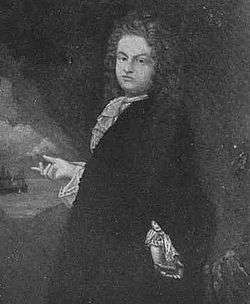Margaret Hardenbroeck
Margaret Hardenbroeck (c. 1637 – c. 1690) was a merchant in the colonial Province of New York, and the wife of Frederick Philipse, Lord of Philipse Manor. She was the daughter of Adolph Hardenbruk, a German emigrant who lived in New Jersey across from the Dutch colony of New Amsterdam.[1]
Early life
Born "Margareta",[2] she established herself in the burgeoning city in the late 1650s[3] working in as an agent for her cousin, Wolter Valck, an Amsterdam trader.[4] She traded pins, cooking oils and vinegar in exchange for furs.[4]
British seizure
Margaret Hardenbroek's marriage to her second husband, Frederick Philipse, was conducted under Dutch law that permitted women to maintain their legal identity and do business in their own name, called usus. In addition, she signed a prenuptial agreement with him ensuring that her daughter would inherit all her former husband's wealth, as well as all or part of his and theirs together. Margaret Hardenbroek owned house lots in Manhattan and Bergen, and several ships including the New Netherland Indian, Beaver, Pearl, and Morning Star.[5]
In 1664, the British seized control of New Amsterdam and under the new laws of the British many of her rights were taken away.[3] Though an accomplished businesswoman and merchant,[4][6] as a woman she was no longer considered legally independent.[3] She was unable to purchase goods under her own authority or act as legal agent. In addition, all the profits that had been made by her thriving businesses were now legally her husband's.[3] Margaret Hardenbroeck continued to run the businesses, and with her wealth her husband was able to expand his holdings and become one of the wealthiest men in New York.
Together the couple purchased many properties, and expanded their transatlantic trading ventures,[3] From her first marriage, Margaret owned several ships, one of them the King Charles.[3] She made several voyages between Europe and America on these as supercargo[3] responsible for all the purchases and sales of goods.[3] Among the Philipses' top cargoes were slaves, being regarded among the biggest slaver traders in the northern Colonies, who also used slave labor extensively in their businesses and operation of their 52,000 acre Manor.
In 1698, though long a member of the governor's Executive Council, the British governor, Lord Bellomont, banned Philipse from government office for conducting a slave trade into New York.[7]
Personal life
First marriage
In 1659, she married Peter Rudolphus de Vries but continued to do business under her maiden name.[3] In 1660, they had a daughter:
- Eva de Vries (b. 1660), who married Jacobus Van Cortlandt (1658-1739)
- Frederick Van Cortlandt
- Mary Van Cortlandt, who married Peter Jay (b. 1701) in 1728
- John Jay (1745-1829)
In 1661, her husband died, leaving considerable property.[6]
Second marriage

In 1662, she married Frederick Philipse (1626-1702),[3] a merchant who through trade with the Indians and good relations with the governors had become one of the leading men of the Colony.[1] Upon their union, the court of Orphan Masters of New Amsterdam required her to render an inventory of her child's parental inheritance. Owing to its unsettled state she was unable to do. Her husband overcame what were considerable difficulties by adopting her two-year-old daughter Eva, promising that if he had no children of his own she would inherit half of his estate, and if other children were born she would share equally with them.[1]
Together the couple had eleven children:[8]
- Philip Philipse (1663-1699)
- Adolphus Philipse (1665–1750)
- Annetje Philipse
- Adolph Philipse
- Anna Philipse
- Rombout Philipse
- Frederick Philipse
- Charles Philipse
- Hendrick Philipse
- Catherine Philipse
- William Philipse
References
- 1 2 3 Savery, Florence M., Cold Springs Recorder, 1912
- ↑ http://wc.rootsweb.ancestry.com/cgi-bin/igm.cgi?op=GET&db=mila2&id=I09755
- 1 2 3 4 5 6 7 8 9 10 Mays, Dorothy A. (2004). Women in Early America: Struggle, Survival, and Freedom in a New World. ABC-CLIO. p. 295. ISBN 1-85109-429-6.
- 1 2 3 Catterall, Douglas (2012). Women in Port: Gendering Communities, Economies, and Social Networks in Atlantic Port Cities, 1500-1800. BRILL. p. 183. ISBN 90-04-23317-2.
- ↑ "Margaret Hardenbroek De Vries Philipse". The National Society of Colonial Dames in The State of New York. Retrieved 8 March 2015.
- 1 2 Appleton, W.S. The Heraldic Journal, Recording the Amorial Bearings and Genealogies of American Families, Wiggen & Lunt, Boston, 1867
- ↑ Lewis, Tom (2007). The Hudson: A History. Yale University Press. pp. 109–112. ISBN 0-300-11990-9.
- ↑ Philipse profle at geni.com